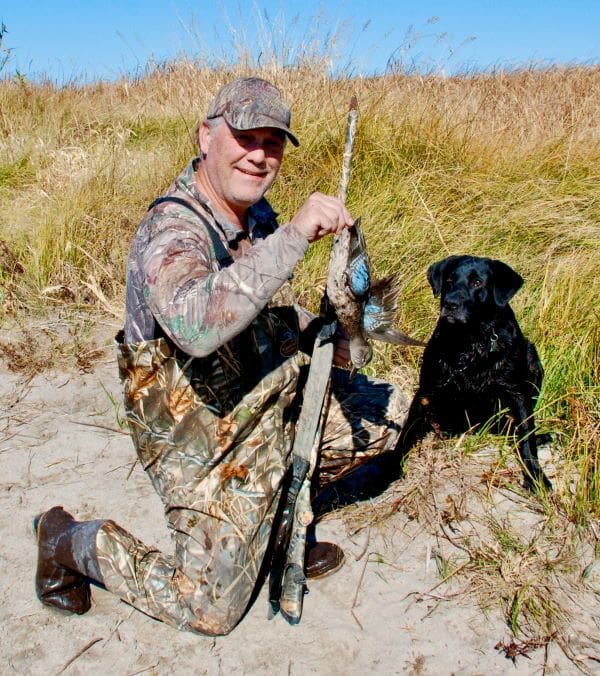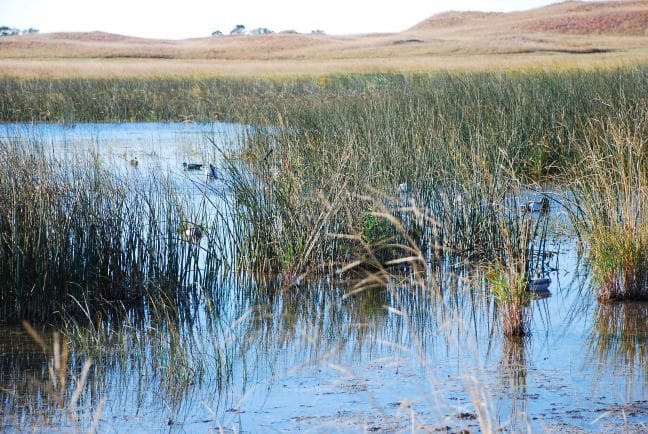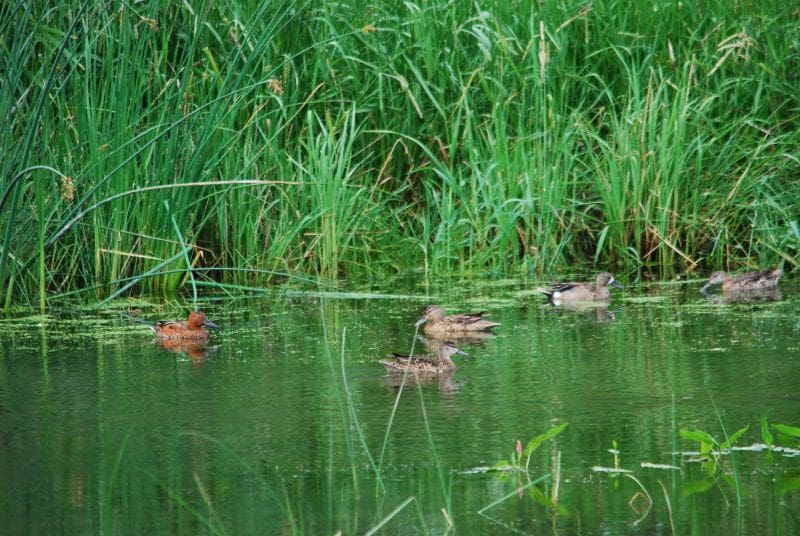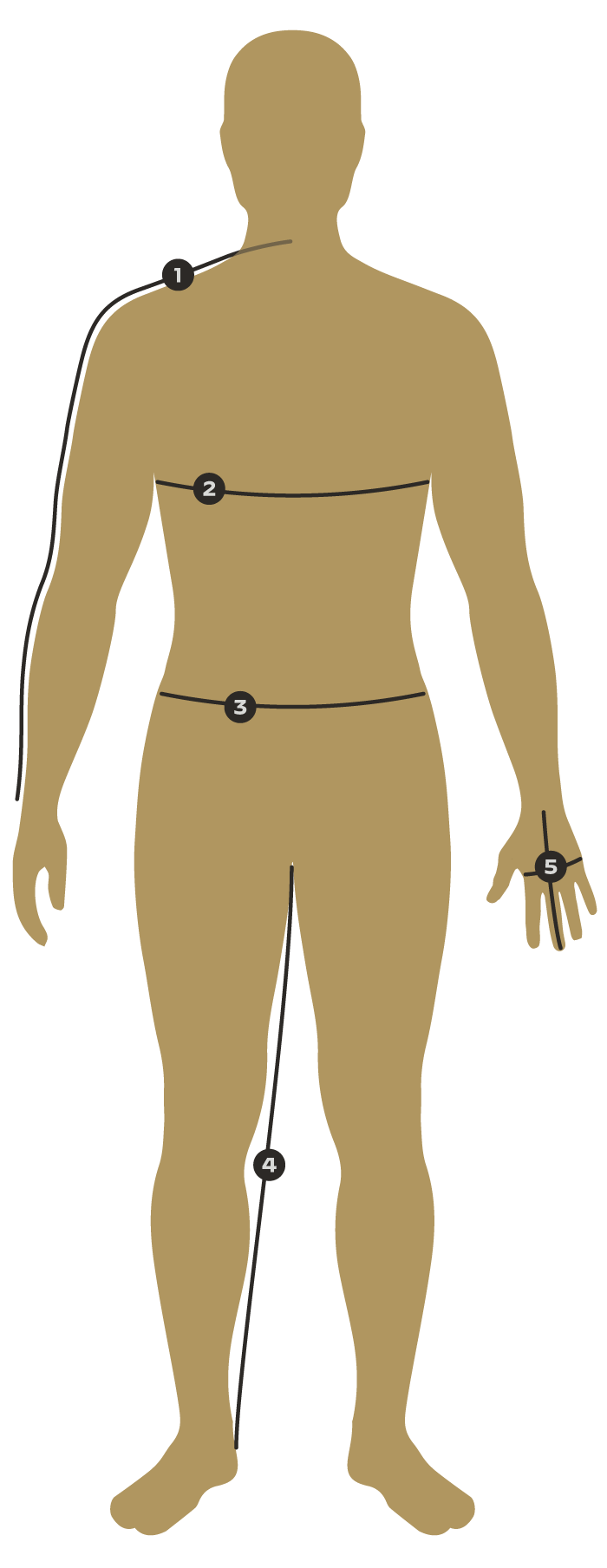Waterfowlers know that the best hunting occurs late in the year when the weather is nasty, and birds are piling in from the north. But we can’t wait until then. Most take advantage of early teal to scratch the itch. When hunters talk about early-season teal hunting, they typically refer to blue-winged teal. Many blue-winged teal nest in the Prairie Pothole Region of South and North Dakota and the Canadian prairies.
Blue-wings are late-summer and early-autumn migrants. Over 5 million blue wings leave their breeding grounds in August and continue migrating through September and October. Their wintering grounds include southern California, southern Texas, the Gulf Coast, the Atlantic Coast, the Caribbean, and South America.
The green-wing teal typically nests only in Canada, Alaska, and some northern portions of the United States. Greenwings migrate much later than blue wings and are much hardier birds. Most of us recall shooting green-wing teal in a November blizzard or when ice threatens to end the season. So, when discussing early-season teal, we generally talk about blue-winged teal.
Surprisingly, blue-wing and green-wing teal are not closely related. Green wings belong to the genus Anas, which includes mallards, pintails, and black ducks. Blue wings belong to the genus Spatula and are more closely related to shovelers. Green-wing teal offers some early-season opportunities in certain areas, but hunters target predominantly early migrating blue-wings in the early September season.
Blue-winged teal have definite habitat preferences. Blue-wings love shallow water and mud flats where they can eat seeds and invertebrates. You’ll find blue-wings yearly on shallow estuaries and bays, but just as often, you’ll find concentrations of teal on sheet water and seasonal floodings and ponds that weren’t there the year before. Teal abundance is directly related to late summer and early fall rainfall. Because these here-today-gone-tomorrow water sources are very seasonal, scouting is paramount.
It pays to keep an eye on the weather map when scouting. If you’re experiencing a wet summer, expand your search to find more temporary water sources teal may have discovered. Otherwise, concentrate your scouting efforts on known estuaries, bays, and permanent lakes and ponds when water is scarce.
Keep an eye on the weather map for early-season cold fronts that could trigger migrations. Take advantage of tools like the DU Waterfowl Migration Map . “We will see migration map posts increase dramatically in September as people begin noticing the first flights of bluewings moving south,” says DU Web Director Anthony Jones. “If you are seeing these early migrants, submit a report, and see if another report is submitted south of your location in a couple days.” A front may push birds already there out or bring new ones in. Scout relentlessly because you can never have too many spots to fall back on.
Teal will pitch in to just about any decoy spread, but you can hedge your bet using life-like teal decoys. A good plan would be to buy a couple dozen Hardcore Rugged Series Green-Wing Teal Floaters (www.hardcorewaterfowl.com/products/rugged-series-green-winged-teal-floater-decoys) or Hardcore Rugged Series Blue-Wing Teal Floaters. Migrating bluewings are still in eclipse plumage until they reach their wintering grounds, so the dull-colored hens are perfect for the early season. Teals also like to hang out with coots, so a few coot decoys in your spread can be the ideal confidence decoys.

The Hardcore Rugged Series Teal line epitomizes the company’s dedication to providing quality products. With their cutting-edge Fowl Flex Technology, these one-piece decoys are virtually indestructible, ensuring they stand the test of time. The true-to-life paint schemes and superior feather detail combined with the WhaleTail™ Keel guarantee lifelike movement will have early-season bluewings committing suicide. Rig the decoys with Texas-style anchors to quickly deploy a spread in the shallows that teal typically frequent.
Some savvy hunters swear by spinning-winged decoys for early-season teal. Others don’t. It can’t hurt. If teal bomb your spread with the spinners out, leave ‘em. If not, it’s easy to pull them.
Calling teal can seal the deal. Hen teals make a fast, shrill call that is a series of three to five calls that sound like the duck is laughing. The first note receives the most emphasis, with the subsequent calls trailing off quickly. Drake bluewings peep and whistle. Their call can be imitated with a pintail/widgeon whistle. Several manufacturers like Buck Gardner, Haydel, Primos, and others make calls specifically for teal.
Teals have a habit of showing up right at shooting time. To promote positive identification of birds, daily shooting hours typically start at sunrise versus a half hour before sunrise like later in the regular season. The flight is often short and sweet, so you must be ready. Being in the “X” is critical as teal are often very specific about where they want to land. If you see a couple of flocks of teal land in a particular location, don’t wait to move. Teal will sometimes trade through mid-morning, but taking advantage of the first light flurry is mandatory in case they don’t.
Teal give the impression of great speed, but they aren’t that fast. But the propensity to turn, twist, rise, bank, and fall makes them look that way. In addition, migrating teal tend to travel in sizeable flocks. When you have a couple of dozen twisting, darting targets buzzing your blind, it’s not unusual to be left with an empty chamber, no birds, and your mouth agape. Knowing exactly when to shoot incoming teal will significantly affect how many birds you end up with on your bird strap. If letting them land and jumping them up doesn’t conflict with your morals, it’s probably the best way to fill a limit.
Early-season teal presents the perfect opportunity to try a smaller gauge gun you’ve been wanting to try on waterfowl. A 20-gauge, or even 28-gauge, is the ideal medicine for diminutive teal. Ammo manufacturers have noted the interest in teal hunting and have created species-specific loads for the speedsters.
Fiocchi (fiocchiusa.com) manufactures bismuth loads in 20 gauge and a new 28-gauge load in their Golden Waterfowl Bismuth line. These loads are ideal for semi-autos, thin-walled doubles, and challenging teal. They come in 3-inch shells in number 4 bismuth shot, which produces exceptionally dense patterns and packs a wallop.
Kent Cartridge (kentcartridge.com) and Hevi-Shot (hevishot.com) produce shot shells specifically for teal. Kent TealSteel is explicitly designed for fast-action and early-season teal. It is loaded with smaller pellets of Precision Steel shot to deliver lethal patterns and consistent performance. It’s available in 12- and 20-gauge, 3-inch loads of 5 and 6 shot.

Anyone who’s ever gone to the plug without touching a feather on a hard-crossing teal can appreciate the velocity advantage that HEVI-Teal offers. Its all-steel payload leaves the muzzle at significantly higher speeds of 1500 fps. Besides reducing how much you must lead a strafing teal, the velocity delivers more downrange energy. Combine that with a best-in-class wad and precision manufacturing techniques, and you get more lethality and feathers.
HEVI-Teal is available in 2-3/4 and 3-inch 12-gauge shells loaded with number 6 shot and a 20-gauge, 3-inch version stacked with number 6 shot.
A side benefit of hunting blue-wing teal is that they may be the best-eating ducks. Their flesh is mild and lighter colored than that of other ducks. They usually have a thick fat layer accumulated for their long journey. Roasted, grilled, or used as hors’ devours, they are all delectable.

Hunting early teal allows you to usher in a new season, bemoan your less-than-stellar shooting, and enjoy the delectable fruits of your labor. It’s also a good time to introduce a kid or a newcomer to hunting, as the weather is often warm and more enjoyable, with minimal need for any cold weather gear.
If you haven’t done it yet, hunting teal gives you a chance to hone your lead, say a few cuss words when you miss, and barbecue some of the finest duck meat on the planet.
Teal may be small in stature, but they can also be big fun.

